Helen Dryden is a Leeds based artist who combines abstract and figurative imagery in drawing and painting as a way to explore the tension between her external ‘reality’ and inner imagination, often veering into absurdity. She recently graduated (virtually) with an MA in Curation Practices from Leeds Arts University and earlier this year launched Compact Contemporary, a small gallery space that she curates.
Court Spencer caught up with her at her studio at Sunny Bank Mills to find out more about her work and what she’s up to.
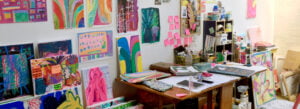
Studio desk.
Court: Wow this place is amazing – and so colourful! Thanks for having me over. Obviously, I didn’t come far as your studio is in the next building to mine at the fabulous Sunny Bank Mills. You’ve been here for about 18 months now. So how are you finding it? Has the studio had an impact on the work you make, or the approach you take with your work?
Helen: Thanks for coming over to chat. I feel really lucky to have a studio here and am aware a lot of people would love to have the luxury of a dedicated workspace like this. Previously I worked from home, which of course limited how big I could work and how messy I could be. Here I feel really free – I can make larger work and be messier so I’m more expressive with my mark making and brush work. It’s also better that I can leave completed work out, so I constantly review it and it feeds into my current work.
It’s also really good to be around other artists and makers to chat about ideas and get regular feedback and encouragement. We also talk via social media and I’m hoping we will be able to get together for social events when it’s safe to do so.
Court: I know you primarily work with acrylic on canvas, but can you tell us a little more about your work?
Helen: I have various threads of starting points that set me off on making a painting. I often start with a drawing, which can be from direct observation, from a photograph (usually one I took myself), or from my imagination. Other times I begin by making marks or stains on the canvas and return to them later and react to those spontaneously.
Being instinctive is really important to me at the moment and not to overthink things. I have worried in the past that I don’t stick to one theme or subject and I had this idea that artists have to deeply explore one thing by repetition. But I’m now in a process where I’m painting whatever I feel like and that’s working well for me. I am making a lot of work and the ideas just keep coming.
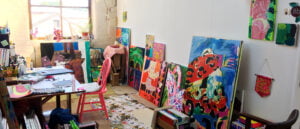
Studio wall.
Court: It sounds like you’re really getting into a flow. You describe your subject matter as veering on the absurd. What inspires you and where does this combination of imagery come from?
Helen: My inspiration comes from things that I find odd or funny or strange. Little things amuse me, like seeing someone wearing a puffa jacket that is much too big for them, charity shop ornaments that are hideous, or muscular heavy metal band Manowar, that sort of thing. It’s a sort of delight in aesthetic perversity I suppose.
The paintings that I have been recently working on and that are in the Leeds Summer Group Show are maybe more heartfelt, as they feature my son exploring the world as some kind of scientist or astronaut. That is to do with my awe at nature and the way children (and all of us) learn by direct participation and being in the world. These paintings came about during the last year or so when we have all been scared about COVID’s effects, and I think that made me think about things close to home.
I’m also really into sci fi or speculative fiction, and love the genre of dystopian fiction, or apocalyptic/post-apocalyptic fiction. At the beginning of the pandemic, I’ll admit that I had a feeling that this was what I’d been waiting for – that my anxiety around a failing world was coming true.
At the other end of the dystopia/utopia spectrum I’m fascinated by late 80s/early 90s rave culture and the optimism of the movement, and the feeling of people being united in music and dancing, and the freedom and love that the music of that time was all about. So I guess all that informs my psychedelic palette and expressive emotional connection with colour and form, and my feeling that reality is always just something that can dissolve into chaos, but that us humans, or some of us, are always trying to remain optimistic, survive and celebrate life – and maybe have a laugh while we are scared at the same time.
Court: You mentioned the 2021 Leeds Summer Group Show – something that really struck me about your work in that was the variation in scale. Is that a factor you’re conscious of within your work?
Helen: There is a practical element to my choice of scale when painting, in that I can’t always afford large canvases! But when I do get the chance to work large I usually make the paintings where I want to use gestural strokes of paint, where the physical act of painting is part of the process and can be ‘read’ by viewers. I don’t know if this is only painters who feel this, but when I stand in front of an artwork in a gallery, part of my brain connects the artist’s creation of the painting to my own hands, arms, shoulders, and I can feel how it felt to make it.
So there is a difference in the viewing experience between looking at small controlled paintings with fine brush strokes, and the fast or big movements of a lively expressive work. I think that the way I paint depends on how I feel that day – sometimes I want exactitude and control (which means I’d probably work small scale) and other days I want explosions and chaos.
My husband also reminded me the other day that I had told him that as a child I had recurring nightmares about objects being the wrong scale, being too near or having too much mass for their size. So I don’t know, but maybe it’s something I hadn’t realised I was quite so sensitive to!
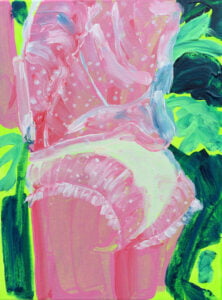
Step nearer the bushes, Joanne (2016) 30 x 40cm – Helen Dryden.
Court: Speaking of scale, can you tell us about Compact Contemporary?
Helen: Compact Contemporary is a micro gallery that I curate, which has a programme of solo exhibitions by emerging artists. The gallery is in a repurposed dolls’ house, at approximately 1/12th scale, and each artist takes over all three floors of the gallery with their art installations for the first 3 weeks of each month.
The exhibitions are viewable on Instagram @compactcontemporary and there are new images and videos uploaded almost every day, so that the exhibitions unfold over time.
I created the gallery early in 2021, primarily as a way for artists to exhibit their work when galleries were closed due to the pandemic. But it is also a way for artists to experiment with making work on a smaller scale, which enables them to create installations that fill the whole gallery. That’s something that they might not have the opportunity to do full size because of the cost of materials and the making time involved, and the difficulties in finding a suitable space to do it in.
Court: Was Compact Contemporary something you were thinking about doing when you were doing your MA?
Helen: When studying for my MA I already had several years’ experience of making art exhibitions of my own and other artists’ work; but I felt that I needed a more formal education in curating to understand the different approaches and current issues surrounding curation, and to have the confidence to use the correct terminology. I wasn’t sure when studying what type of curator I might turn out to be, but during my MA I was able to try out a lot of ideas and meet professionals working in the area.
Compact Contemporary wasn’t something I was thinking about during my MA, though I knew that I wanted to continue working to promote my own and other artists’ work after graduating. One benefit that I hadn’t foreseen was that living with an exhibition in my house and making Instagram interpretation almost every day really embeds the work of the artist in my life. I am immersed, and thinking about it constantly for weeks, looking at it in detail, thinking about how to make it accessible to the online audience. It is quite different from my previous experiences of curating an exhibition, that might be installed and sort of forgotten about until the end of the exhibition (aside from any workshops or events associated with it). What I hadn’t expected was how curating the Compact Contemporary artists’ work has affected how I think about my own work, and given me some new perspectives, which I’ve really enjoyed.
Court: You graduated towards the end of 2020 so part of your MA was done during lockdown. What was that like? And what’s a virtual graduation?
Helen: Like everyone else, I felt quite scared with COVID and was relieved when Leeds Arts University moved to online learning. It was challenging but LAU did their best to provide stability and reassurance, and I felt supported though it was a bewildering time.
Graduation was via Zoom, which was weird, though again, I appreciated that LAU did their best to make it special under the circumstances. They sent all graduates a cap and gown, and drinks and snacks to celebrate with at home. I got my husband to take photos of me in my graduation outfit in the park, and in lieu of a diploma I got myself a swiss roll and tied it with a red ribbon.
Court: Ha, I love the idea of you holding the swiss roll with such pride! That’s brilliant! Have you got a dream project or a direction you would love to take your work in?
Helen: Oh wow, well I feel already like I have a dream life in that I now have a studio and my own petite art gallery and I am regularly meeting inspiring artists (albeit often virtually). Naturally, I want to keep doing what I am doing.
I am inspired by Rose Wylie’s commitment to painting and drawing and how she just kept on making her work in her own very personal style for so many years, unrecognised. For me, art is something I am hugely compelled to do – whenever I have had a full-time job and been unable to paint, I have become depressed. So I’ll carry on working as much as I possibly can, while I can, but I don’t want to envision a ‘dream project’ as I already feel so lucky. I think if I keep working for another 40 years maybe I will make my best work and become “a really good artist”… whatever that is!
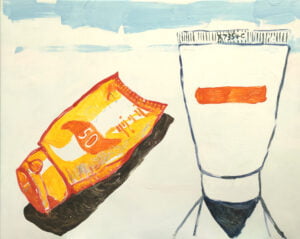
Megatonne guardian (2019) 92 x 73cm – Helen Dryden.
Court: You’re currently in the 2021 Leeds Summer Group Show and are curating Compact Contemporary. Have you got any other projects coming up that we can keep an eye out for?
Helen: I am currently in an online group exhibition ‘Personifying Pleasure’ at Stay Home Gallery and I need to turn my attention soon to making some new designs for my Etsy shop All The Crisps where I sell kitsch, camp and grotesque fan art cards and prints inspired by pop culture like Gogglebox, Reeves and Mortimer, the Royal family.
When it’s safe to do so I want to plan my next IRL exhibition of my newest paintings but I’m not sure when that will be. Wait and see I guess!
Court: I’ll be sure to keep an eye on your Insta and website for updates. Thank you so much for letting me snoop through your studio, it’s been the most colourful to date. It was so exciting to see some of your paintings in real life that I had admired online and I can’t wait to see more of your work.
Filed under: Art & Photography
Tagged with: acrylic, art, art and photography, court Spencer, Helen Dryden, leeds, Leeds art, Leeds arts university, leeds summer group show, painting, Studio, Sunny Bank MIlls
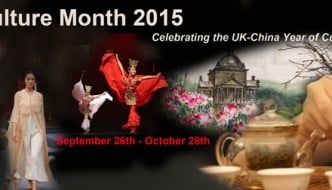
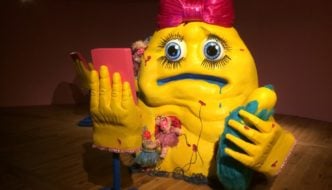
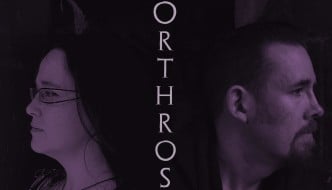
Comments